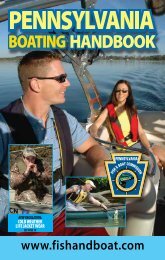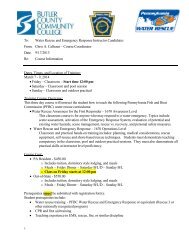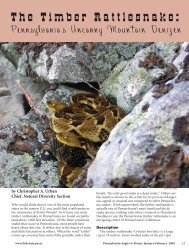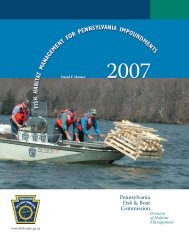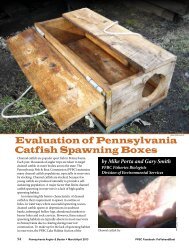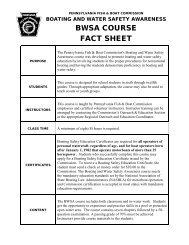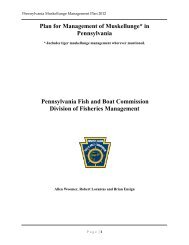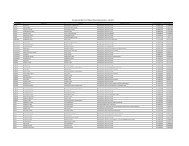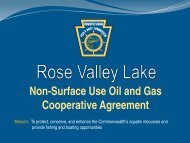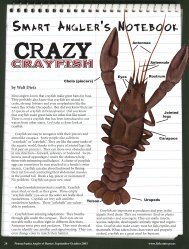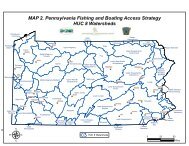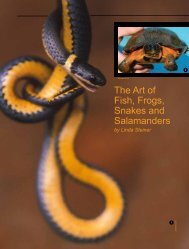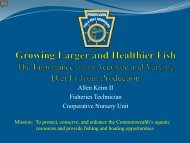Pennsylvania Amphibian And Reptiles : A Curriculum Guide Sampler
Pennsylvania Amphibian And Reptiles : A Curriculum Guide Sampler
Pennsylvania Amphibian And Reptiles : A Curriculum Guide Sampler
Create successful ePaper yourself
Turn your PDF publications into a flip-book with our unique Google optimized e-Paper software.
“Herp” Sweet Home<br />
Adapted from “Water, Water Everywhere,” in Living in Water, Edition 1 (Baltimore, Md.: National Aquarium, 1987).<br />
GRADE LEVELS:<br />
6 – 12<br />
SUBJECT AREAS:<br />
Environmental Studies,<br />
Science<br />
DURATION:<br />
2 sessions<br />
SETTING:<br />
Classroom<br />
SKILLS:<br />
Classifying, comparing,<br />
concluding, describing,<br />
developing vocabulary,<br />
following directions,<br />
interpreting, reading,<br />
reasoning<br />
VOCABULARY:<br />
Biome, bog, deciduous<br />
forest, dichotomous key,<br />
habitat, marsh, swamp,<br />
vernal pool, wetland, wet<br />
meadow<br />
CHARTING THE<br />
COURSE:<br />
Class Field <strong>Guide</strong>;<br />
Herpetology Field Trip;<br />
“Herp” Habitat Haggle;<br />
Park It Here!; Before the<br />
Well Runs Dry; Carry On!;<br />
What Every “Herp” Needs;<br />
Froggy Swamp; What Do<br />
You Know About “Herps?”;<br />
Oh “Herps!”; Isn’t That<br />
Special?<br />
“HERP” HAPPENINGS:<br />
A Tiny Turtle in Danger of<br />
Disappearing; Leave No<br />
Stone Unturned; Sandstone<br />
and Salamanders; Swamp<br />
Rattlers<br />
Summary<br />
Students use a dichotomous key and<br />
a flow chart to classify common<br />
<strong>Pennsylvania</strong> habitats. Each of these<br />
habitats is a potential home to many<br />
species of amphibians and reptiles.<br />
Objectives<br />
Students in grades 6 through 8 will<br />
define habitat.<br />
use a flow chart and a dichotomous<br />
key.<br />
name and describe three different<br />
<strong>Pennsylvania</strong> habitats.<br />
Students in grades 9 through 12 will<br />
analyze the usefulness of dichotomous<br />
keys to scientific investigation.<br />
describe several habitats, listing the<br />
typical vegetation and other defining<br />
properties.<br />
given a habitat type, name two amphibians<br />
or reptiles that live in that habitat.<br />
Materials<br />
Copies of Key to <strong>Pennsylvania</strong> Habitats<br />
(page 147); copies of <strong>Pennsylvania</strong><br />
Habitat Flow Charts (pages 149–151);<br />
copies of habitat cards (pages 153–167),<br />
one per student.<br />
Background<br />
Dichotomous keys are used in<br />
science to classify many types of things,<br />
usually living organisms. The user is<br />
offered two choices at each step, and by<br />
choosing between the two the user is led<br />
to an answer or to another choice.<br />
These keys can seem daunting at first<br />
due to their minute detail. Introducing<br />
students to a simple key allows them to<br />
become accustomed to the concept<br />
without being overwhelmed. A flow<br />
chart offering two choices at each step<br />
is essentially the same as a key, but the<br />
layout of the flow chart can help<br />
children visualize how a dichotomous<br />
key works.<br />
<strong>Pennsylvania</strong> <strong>Amphibian</strong>s and <strong>Reptiles</strong><br />
Habitat “Herp” Sweet Home<br />
The entire state of <strong>Pennsylvania</strong> is<br />
part of a temperate deciduous forest<br />
biome, a biome characterized by midrange<br />
temperatures and high levels of<br />
precipitation. The final stage of ecological<br />
succession in <strong>Pennsylvania</strong> is a<br />
deciduous forest dominated by large<br />
hardwood trees such as oak, maple, and<br />
beech. Before the European settlement<br />
of this state, about 98 percent of it was<br />
covered by forest. Today, only small,<br />
inaccessible patches of old growth forest<br />
remain, notably in Cook Forest State<br />
Park, Susquehannock State Forest, and<br />
Bald Eagle State Forest. Second and<br />
third growth forests now cover approximately<br />
60 percent of the state. A major<br />
part of <strong>Pennsylvania</strong> has been cleared<br />
for agriculture, the number one industry<br />
in the Commonwealth. As the population<br />
grows, more and more land is<br />
becoming residential, and wildlife and<br />
humans must share backyard habitats.<br />
In rural areas, and even in some suburbs,<br />
small stands of second growth trees dot<br />
the landscape. These woodlots are<br />
home to many species, including several<br />
amphibians and reptiles.<br />
The forest was not the only habitat<br />
found in <strong>Pennsylvania</strong> before colonial<br />
times. There were naturally occurring<br />
meadows or prairies (the result of pond<br />
or lake succession), and the mountainous<br />
regions of the state contained rocky<br />
outcrops that still exist today. Aquatic<br />
habitats abounded, including over<br />
50,000 miles of flowing water. (In fact,<br />
Alaska is the only place in the United<br />
States that has more miles of rivers and<br />
streams than <strong>Pennsylvania</strong>.) Unfortunately,<br />
some of this flowing water has been<br />
degraded by human activities like farming,<br />
industry, and mining. Abandoned mine<br />
drainage is the primary pollutant,<br />
impacting more than 3,000 miles of<br />
<strong>Pennsylvania</strong> streams. It may come as a<br />
surprise that there were far fewer lakes<br />
and ponds in <strong>Pennsylvania</strong> prior to the<br />
143



